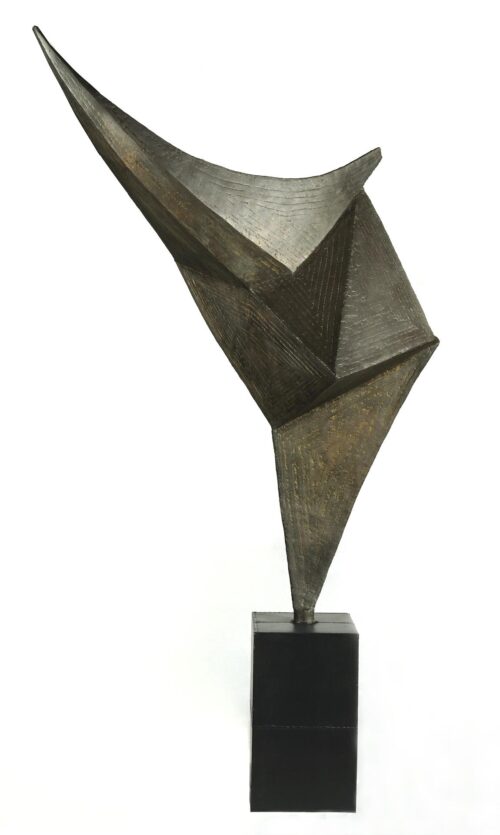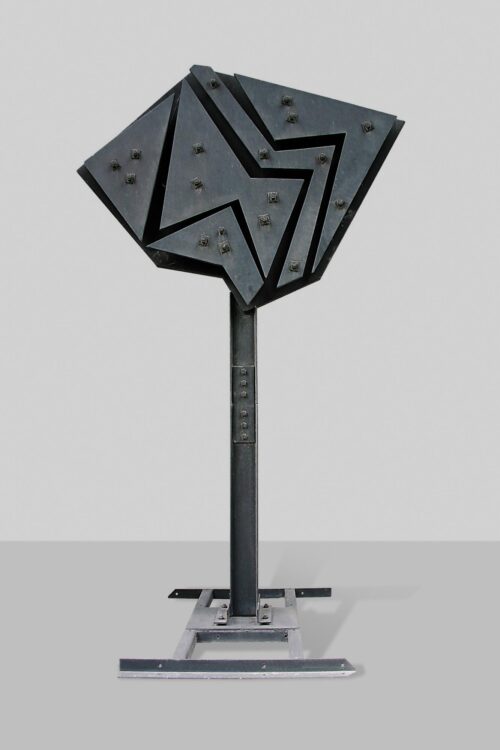
Koulentianos Kostas (1918 - 1995)
Thunderbolt, 1964
He studied sculpture at the Athens School of Fine Arts in 1936-1939 with Thomas Thomopoulos, Kostas Dimitriadis and Michalis Tombros. In 1945, on a French government scholarship he went to Paris to continue his studies. In 1946, he attended courses at the Ecole des Beaux Arts but shortly left in order to become Ossip Zadkine’s pupil at the Academie de la Grande Chaumiere. His acquaintance with the sculptor Henri Laurens in 1947 was of decisive importance, as Koulentianos collaborated with him until the latter’s death, in 1954. His works of this period bear the influence of the French sculptor, with whom – beyond the master-pupil relationship – Koulentianos developed close friendship. In 1952, he travelled to Morocco. His impression of the desert found expression in his work. During his eight-month stay in Greece in 1955, archaic Greek sculpture also attracted his attention. In 1961, the writer Roger Vaillant helped him to obtain a workshop at Meillonas Ain, enabling him to create large-scale sculptures. During the same period, his acquaintance with the architect Pierre Dosse stirred his interest in the incorporation of sculpture in architecture.
He was very active regarding presentation of his work in both solo and group exhibitions. His first solo exhibition took place in Casablanca (1952), followed by solo exhibitions in Athens, London, Paris and other European and American cities. Following his death, in 1997, a retrospective exhibition of his work took place at the Couvent des Cordeliers, Paris. He also participated in group exhibitions, including the Salon d’Automne in 1946, the Salon de la Jeune Sculpture and the Salon du mai, as well as the Sao Paulo Biennale (1955) and the Venice Biennale (1964). He also participated in group and Panhellenic exhibitions in Greece.
Koulentianos’s sought to distance himself from academic sculpture, a fact which became evident very early on. His acquaintance with Henri Laurens also contributed to that. During 1947-1952, the French sculptor’s influence was particularly strong in his work. Stylised female figures, seated or reclining, prevail, with accentuated organic curves and motion. In 1952, iron, and metals in general, won him over; his shift from organic towards geometric abstraction was constant, climaxing in the early 1960’s. His production of this period is characterized by geometric forms, which establish themselves dynamically in space and create an effect of motion. In the 1970’s, his “screw” sculptures became his trademark. Curved or flat surfaces of white- or black-painted iron are joined by iron blades, resulting in compositions with clear, dynamic forms conversing with space and light. During 1979-1990, these 3-D compositions evolved in 2-D constructions extending vertically as well as in the “Generations” series, in which the introduction of the void has a major contribution to the overall effect. Besides sculptures and reliefs, he also created collages and tapestries, similar in style to his sculptures.

Thunderbolt, 1964

New Generation no. 3, 1982

Abstract, [1974]

Sea Victory, 1954

We use cookies to make our site work properly, to personalize content and ads, to provide social media features and to analyze our traffic. We also share information about how you use our site with our social media, advertising and analytics partners. Read the Cookies Policy.
These cookies are necessary for the website to function and cannot be switched off in our systems. They are usually only set in response to actions made by you which amount to a request for services, such as setting your privacy preferences, logging in or filling in forms. You can set your browser to block or alert you about these cookies, but some parts of the site will not then work. These cookies do not store any personally identifiable information.
If you disable this cookie, we will not be able to save your preferences. This means that every time you visit this website you will need to enable or disable cookies again.
These cookies tell us about how you use the site and they help us to make it better. For example these cookies count the number of visitors to our website and see how visitors move around when they are using it. This helps us to improve the way our site works, for example, by ensuring that users find what they are looking for easily. Our website uses Google Analytics for statistics reporting.
Please enable Strictly Necessary Cookies first so that we can save your preferences!